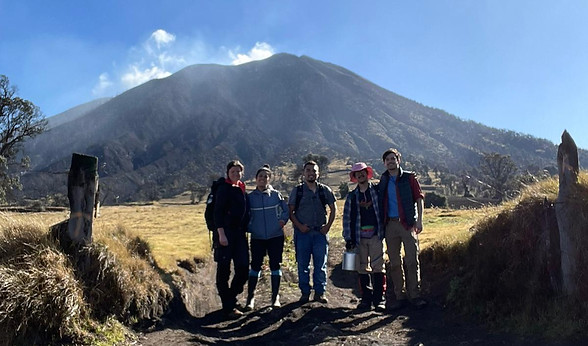
Our Work
Our research spans the topics of biogeochemistry, global change biology, and ecosystem ecology; from latitudes in the arctic circle to the equator; and at scales of ecosystems or individual plants and microbes.
Uniting these topics, places, and scales are the biotic and abiotic interactions that move energy and nutrients through ecosystems. The bulk of our work investigates relationships between plants and soil microbes that impact terrestrial carbon capture and nutrient dynamics.
Below is description of some of our current projects as well as the fields of study that inform them. At the bottom of the page is a summary of some of the themes that emerge through this diversity of projects and guide our next steps.

Global Change
The ultimate goal of our work is to understand how natural ecosystems are responding to unprecedented global change and how the responses of these ecosystems, in turn, influence the trajectory of global change itself
Ecosystem Ecology
We approach our work with an ecosystem focus. This means that we are interested in how the biogeochemical interactions that transfer materials through an ecosystem dictate the way the system operates.
Relevant Fields
Biogeochemistry
A complete mechanistic understanding of how ecosystems work requires us to understand the chemical interactions between the biotic (plants, animals, bacteria, and fungi) and abiotic (soils, water, atmosphere) components of the ecosystem.

This is your Project description. Provide a brief summary to help visitors understand the context and background of your work. Click on "Edit Text" or double click on the text box to start.
Symbiotic Nitrogen Fixation
Nitrogen is one of the most important elements for plant growth and symbiotic nitrogen fixation is a key process that brings nitrogen into terrestrial ecosystems. Our lab investigates the ecological drivers and effects of nitrogen fixation by identifying global patterns and drivers of nitrogen fixation and the distribution of nitrogen-fixing plants using greenhouse studies, field experiments, and modeling work.
Projects
-
Dynamics of N fixation in tropical forest canopy gaps
-
N fixing trees influence tropical forest succession
-
Theoretical models of symbiotic N fixation controls
Example Publications
Researchers
-
Prof. Benton Taylor
-
Dr. Lindsay McCulloch
-
Dr. Wenying Liao
-
Julissa Gutierrez


Forest Responses to Rising CO2
Forests are incredibly important to global biosphere function, but we know little about how they will respond to rising atmospheric CO2. We combine greenhouse experiments, elevated CO2 experiments in the field and observation surrounding natural CO2 vents to better predict the growth, carbon sequestration potential, and nutrient dynamics of temperate and tropical forests as CO2 levels continue to rise.
Projects
-
Duke Free-Air CO2 Enrichment Experiment
-
Global Analyses of Elevated CO2 Data
-
Forest Responses to Volcanically derived CO2 in Costa Rica
-
Open-Top eCO2 Chamber Experiments at La Selva Biological Station

Researchers
-
Professor Benton Taylor
-
Dr. Lindsay McCulloch
-
Dr. Cecilia Cordeo-Prada
Publications



Mycorrhizal Dynamics

The mycorrhizal fungi that partner with plant roots represent a fascinating and critically important set of interactions that impact plant growth and soil health. Our lab focuses on primarily on how mycorrhizal interactions affect tree growth and soil resource acquisition. We work on mycorrhizal dynamics in responses to rising CO2, and our most recent work has begun to focus on dual mycorrhizal colonization, where single plants simultaneously partner with both major groups of mycorrhizae – arbuscular mycorrhizae and ectomycorrhizae.
Projects
-
In-situ measurements mycorrhizal dual colonization at Harvard Forest
-
Effects of changing forest composition on fungal community composition
Researchers
-
Carina Berlingeri, PhD Candidate
-
Nikhil Chari, PhD Candidate
-
Dr. Lindsay McCulloch

Root Exudation
One of the most under-appreciated processes in terrestrial ecosystems is the production of exudates (low molecular weight organic compounds) from plant roots. These exudates can have dramatic impacts on the soil microbial community and help determine soil carbon storage capacities. Our work focuses on how plants change their exudation patterns in response to rising CO2 and temperature and what these changes mean for the soil carbon pool.
Projects
-
Greenhouse exudation collection experiment
-
In-situ root collection across multiple FACE experiments
Researchers
-
Nikhil Chari, PhD Candidate

Arctic Shrub Expansion

The immense amount of carbon frozen in the permafrost of the Arctic tundra is often referred to as the “sleeping giant” of the terrestrial carbon cycle. As polar temperatures rise, several changes to the tundra threaten to release this carbon. Among those changes is the expansion of tall woody shrubs into the tundra, which alter carbon, nutrient, water, and temperature dynamics. Our work focuses on the specific effects that nitrogen-fixing shrubs in the genus Alnus are driving the expansion of woody shrubs into the arctic.
Projects
-
Alder N-fixation rates and controls, and subsequent affects on soil carbon
-
Changing alder distribution and remote sensing
-
Spatial understanding of N-fixation on plant community composition
Researchers
- Calvin Heslop, M.S, PhD Candidate
- Nick Daley
- Millicent Harding, collaborator at Durham University


Additional Projects
Projects
-
Hurricane impacts on tropical forest dynamics
-
Temperate forest recovery following large-scale pathogen die-off
-
Fire-sensing plants in African Savannas




